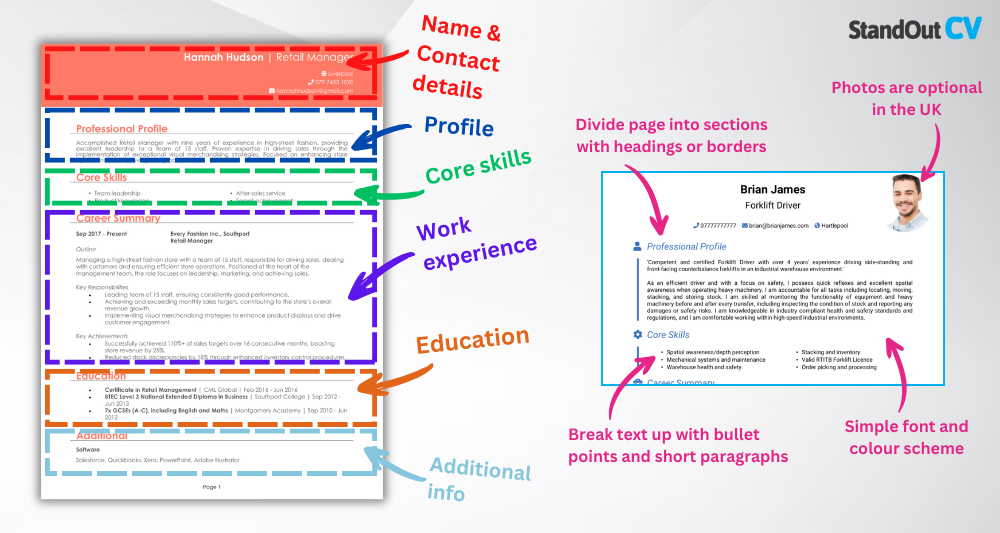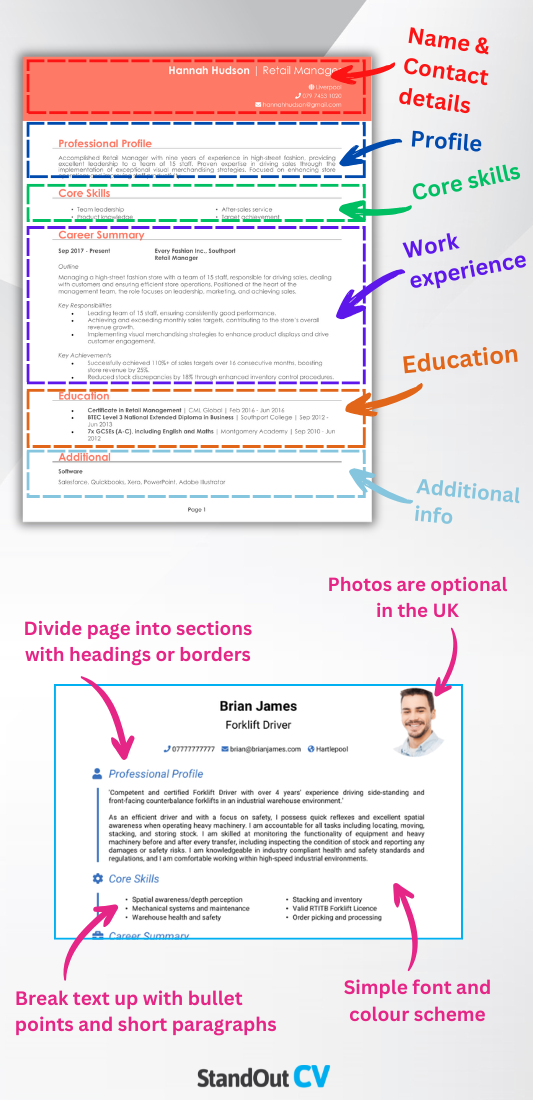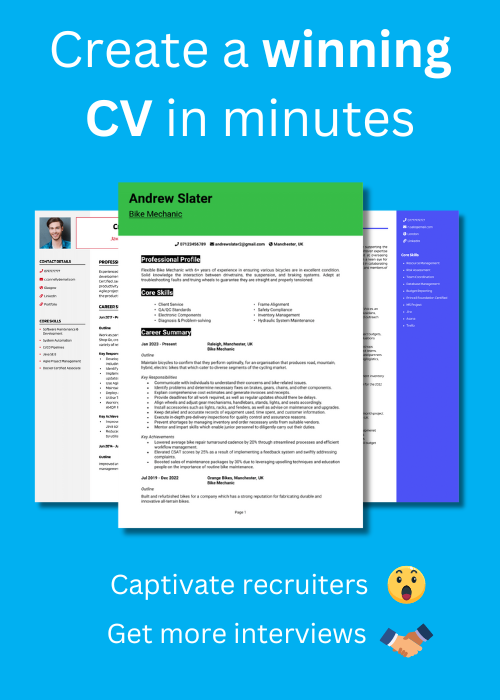Style doesn’t happen by accident – and neither does a good CV. Whether you’re curating high-street campaigns or magazine shoots, your job is about knowing what works and presenting it flawlessly. Your CV should do the same.
With a Fashion Stylist CV example, this guide shows you how to tailor an application that highlights your creative flair, your commercial instincts, and your ability to pull looks, clients, and entire shoots together under pressure.
Fashion Stylist CV

How to write your Fashion Stylist CV
Discover how to craft a winning Fashion Stylist CV that lands interviews with this simple step-by-step guide.
Stylists might work behind the scenes, but your CV needs to shine in the spotlight. From celebrity clients to e-commerce brands, employers want to see more than a good eye – they want proof of collaboration and creativity.
This guide breaks down everything you need to write a CV that reflects your styling expertise – including content guidance and formatting advice.
Fashion Stylist CV format and structure guidelines


Every outfit tells a story – and so should your CV. Your document needs strong structure and effortless readability. Recruiters want to see your creative impact, not scroll through chaos and visual mistakes.
Here’s the layout to follow:
- Name and contact details – Ensure your name and personal details are easily visible at the top. A photo is optional and depends on the role.
- Profile – Craft a short introduction that showcases your professional background and key accomplishments.
- Core skills – Provide a quick overview of your top skills that show why you’re a great fit.
- Work experience – Outline your career progression in reverse order, emphasising your contributions and successes.
- Education – Provide details on your academic background, including certifications or specialised training.
- Additional info – You can add hobbies or activities here that reflect your enthusiasm for the industry.
Use bullet points throughout to keep things easy to scan. Stick to a sleek, professional font and make each section pop with clear headings. White space is your friend, just like negative space in a strong layout. Keep your CV length to two pages max – enough space to showcase your work without losing the reader’s attention halfway through the show. Following these tips for your CV format will help to hold the attention of busy recruiters.
Creating a strong Fashion Stylist profile


This is the front row of your CV – where you let the reader know your style, your experience, and the type of clients or campaigns you work best with. Focus your CV profile on your creative strengths, but don’t forget the organisational power and commercial awareness behind them.
It’s your chance to explain to recruiters the value you bring to a brand or client, and convince them with just a few lines to continue reading, and eventually offer you that all-important interview.
Fashion Stylist CV profile examples
Profile 1
Experienced Fashion Stylist with over 10 years in luxury retail and editorial styling. Worked with global fashion houses, managed runway looks, and led personal styling sessions for VIP clients. Proficient in wardrobe planning, trend forecasting, and visual merchandising across both print and digital platforms.
Profile 2
Skilled Fashion Stylist with six years of experience in commercial advertising and e-commerce. Collaborated with photographers, models, and creative directors to develop brand-aligned looks for campaigns. Familiar with Adobe Lightroom, styling software, and on-set preparation for high-volume studio shoots.
Profile 3
Creative Fashion Stylist with three years of experience at a boutique styling agency, specialising in personal shopping and event wardrobe coordination. Built strong client relationships, curated on-trend looks, and managed fittings for private clientele. Adept at using Pinterest boards and digital lookbooks to communicate style options.
Details to put in your Fashion Stylist CV profile
Include the following:
- Where you worked – Describe the styling environments you’ve worked in – such as editorial, commercial, red carpet, retail, or personal styling.
- Your top qualifications – Mention any fashion-related diplomas or styling courses that show your knowledge of trends, textiles, or visual presentation.
- Essential skills – Highlight your ability to plan, coordinate, and execute cohesive looks across different body types, brand guidelines, or briefs.
- Clients or teams supported – Say who you worked with – from photographers and art directors to private clients and stylists.
- Value delivered – Focus on your creative contribution, time management, problem-solving, or ability to elevate a visual identity.
Show off the core skills recruiters look for


Your core CV skills section should communicate the hard, practical abilities that clients and employers look for in a stylist. These might include anything from visual planning to working under time pressure or sourcing pieces across budgets and locations.
Instead of listing buzzwords, focus on the tasks you’re expected to handle in this job. Tailor this section to match the role you’re applying for – and keep it specific to styling, not general creativity or fashion passion.
Most important skills for a Fashion Stylist
- Wardrobe Curation and Outfit Planning – Selecting clothing and accessories that align with a client’s brief, brand, or event theme.
- Trend Forecasting and Market Awareness – Staying informed on current and upcoming fashion trends to guide styling decisions.
- Editorial and Commercial Styling – Creating looks for photoshoots, advertising campaigns, and fashion publications that align with creative direction.
- Personal Styling and Client Consultation – Advising individuals on style choices based on body type, personality, and lifestyle needs.
- Garment and Accessory Sourcing – Identifying and acquiring pieces from designers, showrooms, or retailers for use in styling projects.
- Fitting Coordination and Alteration Oversight – Organising fittings and collaborating with tailors to ensure perfect garment fit and presentation.
- On-Set Styling and Visual Direction – Managing wardrobe and making real-time styling adjustments during shoots or live events.
- Fashion Show and Event Preparation – Coordinating looks, backstage logistics, and model styling for runway shows and presentations.
- Brand Collaboration and Image Building – Working with fashion brands or public figures to shape and maintain a consistent visual identity.
- Styling Kit and Wardrobe Management – Maintaining an organised styling kit and tracking all garments, accessories, and returns.
Describing your work experience


Stylists rarely have straightforward 9-to-5s – and your work experience section should reflect that. Whether you’ve worked full-time for a retailer, freelanced for glossy mags, or assisted on campaigns, this section shows how and where you’ve made your mark.
List your most recent work first, with a short intro describing the type of projects and clients you worked with. Use bullet points to show the scope of your work, the tasks you handled, and any creative or logistical achievements.
What’s the correct way to structure job history on your CV?

- Outline – Give a brief overview of your styling work: who you worked with, what kind of styling you did, and in what context (e.g. editorial shoots, commercial campaigns, personal clients).
- Responsibilities – Use action words like “styled” and “coordinated.” For example: “styled weekly editorial features in line with fashion calendar” or “coordinated fittings and alterations for a 10-piece brand lookbook.”
- Achievements – Add in quantifiable impact wherever possible: e.g. “featured in 5 national publications”, “helped increase product engagement through visual merchandising revamp.”
Sample work experience for Fashion Stylists
Fashion Stylist | Aurelia Editorial Group
Outline
Styled fashion spreads and runway looks for a high-end fashion publication working with international brands and designers. Delivered seasonal concepts for editorial features and coordinated logistics for studio and location shoots.
Responsibilities
- Planned and executed full outfit styling for editorial shoots across 10+ issues per year
- Worked closely with creative directors to align concepts with brand partnerships
- Sourced garments and accessories from luxury labels and PR agencies
- Managed sample returns and coordinated transport for location-based shoots
- Collaborated with hair, makeup, and photography teams to deliver cohesive visuals
Achievements
- Increased reader engagement by 25% through a best-performing seasonal style feature
- Built a streamlined sample tracking system that reduced return delays by 40%
- Secured exclusive wardrobe access from three top-tier designers for a special edition shoot
Fashion Stylist | Nuvéo E-Commerce Studios
Outline
Provided commercial styling for a large UK e-commerce platform with multiple high-volume product shoots each week. Supported creative teams by delivering consistent, brand-aligned visuals for clothing, accessories, and footwear.
Responsibilities
- Styled 30+ looks daily for womenswear and menswear product photography
- Liaised with photographers and models to maintain pace and visual standards
- Created daily styling decks to ensure consistency across multiple product categories
- Prepped garments for shoot, including steaming, pinning, and fitting adjustments
- Used in-house CMS tools to tag and upload styled looks for approval and publishing
Achievements
- Improved styling efficiency by 20% through revised prep workflows and batching processes
- Contributed to a lookbook refresh that helped increase product conversion by 15%
- Trained three junior stylists to meet daily output targets with styling consistency
Fashion Stylist | Ivy Lane Style Studio
Outline
Curated personal style solutions and wardrobe edits for private clients at a boutique styling agency serving high-net-worth individuals. Specialised in occasionwear styling, closet transformations, and seasonal look planning.
Responsibilities
- Conducted one-on-one consultations to assess client needs and fashion preferences
- Planned and sourced full looks for events including weddings, galas, and photo shoots
- Managed fittings, alterations, and styling prep to ensure event-day readiness
- Created personalised digital lookbooks and Pinterest mood boards for client approval
- Provided post-service follow-up to maintain client relationships and plan future styling
Achievements
- Achieved a 98% client retention rate across two years through consistent personalised service
- Generated £40k in revenue through referral-only VIP packages
- Reduced client wardrobe redundancy by 35% via smart seasonal capsule planning
What should your CV’s education section include?


Fashion is visual, but that doesn’t mean your education doesn’t count. Use this section to show that you’ve studied design principles or visual merchandising – or that you’ve taken professional styling courses to sharpen your instincts.
List your qualifications from most recent to earliest. Whether you studied fashion styling at university or completed a diploma from a specialist academy, include it here. Short courses in photography, branding, or trend forecasting can also add value if relevant to your approach.
What qualifications do employers look for in a Fashion Stylist?
- Diploma in Fashion Styling – Offers hands-on styling knowledge and experience with shoots and fashion theory
- BA in Fashion Design or Fashion Communication – Covers the industry and visual presentation from a broader angle
- Short courses in trend forecasting, colour theory, or wardrobe styling – Shows continuous development and understanding of styling tools
- Visual Merchandising Certificate – Useful for in-store or brand-related styling
- Fashion Retail Academy styling programmes – Practical and industry-specific qualifications recognised across the UK





